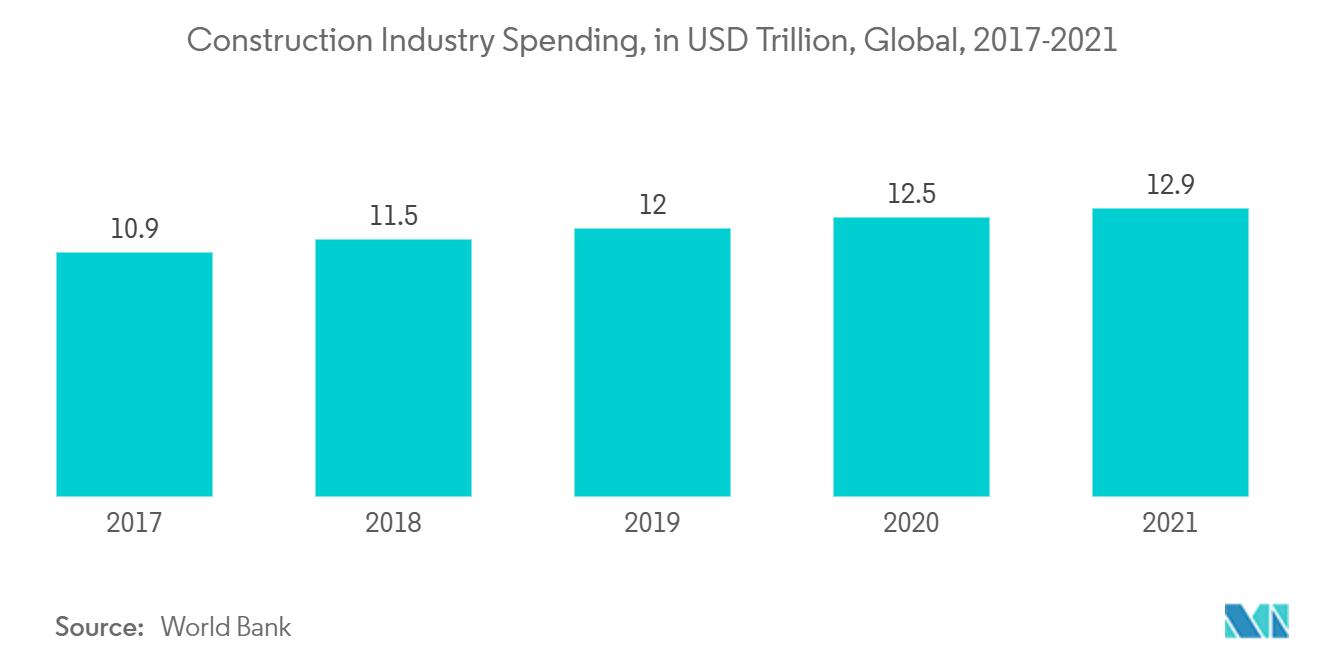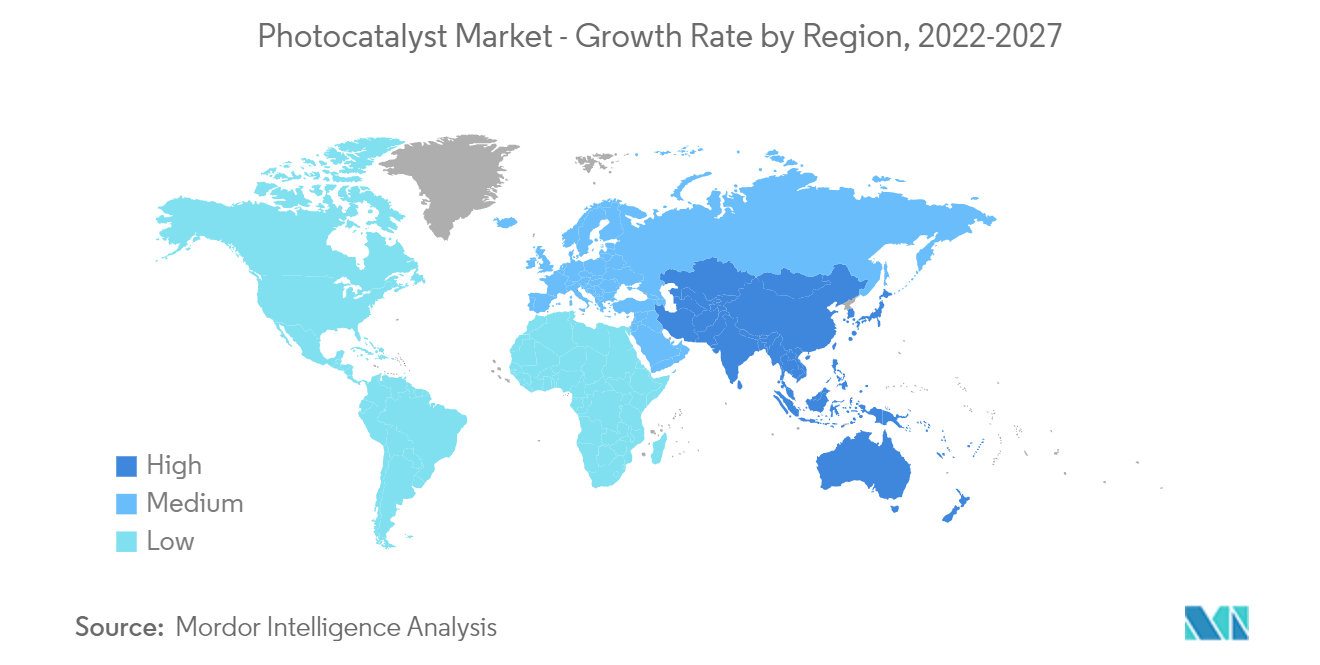Market Trends of Photocatalyst Industry
This section covers the major market trends shaping the Photocatalyst Market according to our research experts:
Increasing Demand from Self Cleaning Application
- Photocatalytic self-cleaning is probably the most widely used nano-function in building construction. Numerous buildings around the world make use of this function. Its primary effect is that it greatly reduces the extent of dirt adhesion on surfaces. Another advantage is that light transmission for glazing and translucent membranes is improved since surface dirt and obscure grime sunshine are less, which can reduce lighting energy costs.
- Photocatalytic paints and coatings have been developed in recent years to coat the outer surface and interiors of the building. Photocatalytic coatings not only wash off dirt but also break down contaminants and stains: airborne pollutants, and smog from the exterior surfaces of the building. Furthermore, photocatalyst coatings remove odors and break down VOC, airborne viruses, and bacteria from the interior furniture of the building. Moreover, photocatalyst coating is one of the major options preferred to protect wooden surfaces in the interior of the building.
- The application of photocatalytic material is not limited exclusively to large buildings. It can be equally appropriate, for example, for conservatories and winter gardens. In road building, the transparent coating can also be used, for example, for noise barriers. Tiles with baked-on durable coatings are available for use both indoors and outdoors. Likewise, concrete, another common building material for facades, can also be equipped with a self-cleaning surface. Hence the construction sector will contribute majorly to the demand for self-cleaning photocatalytic materials in the forecast period.
- The global construction industry is growing at a healthy rate. Asia-Pacific, along with the Middle East and African regions, is witnessing huge investments in the construction sector due to numerous market opportunities available in these markets.
- According to the National Bureau of Statistics of China, China's construction output value peaked in 2021 at roughly CNY 29.3 trillion (USD 4.2 trillion), compared to CNY 26.39 trillion (USD 3.79 trillion) in 2020.
- According to The Ministry of Land, Infrastructure, Transport, and Tourism (Japan), total construction investment in Japan was over JPY 66.6 trillion (~USD 498.10 million) in the fiscal year 2021, with building construction accounting for more than half of this expenditure. Total construction spending is expected to reach almost JPY 67 trillion (~USD 501.09 million) in the fiscal year 2022.
- In Europe, Germany has taken the lead in developments in the construction sector. Alexander Berlin's Capital Tower and Estrel Tower are some of the major high-rise buildings the country is developing at present. The construction sector is further rising in the country owing to significant investments in its infrastructural sector and further due to the rising demand for residential units.
- According to World Bank, the construction industry grew to a spending value of USD 12.9 trillion in 2021 and is expected to grow by three percent per annum. This comprises real estate developments, both residential and commercial, as well as infrastructural and industrial constructions. Data on construction spending cover labor and material costs, architectural and engineering work, and taxes.
- The self-cleaning photocatalytic coating is used to coat optically transparent glass materials, which are used in many applications, including automobile windshields, window glass, skyscrapers, microscopes, eyeglasses, solar cell panel covers, kitchen appliances, screens of many electronic devices, and optical instruments.
- The self-cleaning photocatalytic coating on low-cost, lightweight, and flexible PC substrates is crucial for multifunctional self-cleaning devices to be useful. Therefore, other end-user industries, such as automobile, electronics, medical, and solar energy generation, will also contribute significantly to the demand for self-cleaning photocatalytic material in the forecast period.
- All the aforementioned factors will contribute towards industry growth during the forecast period.

Asia-Pacific Region to Dominate the Market
- Asia-Pacific dominates the photocatalyst market in terms of market share and market revenue. The region is set to continue its dominance over the forecast period.
- The super-hydrophilic nature of photocatalysts imparts the self-cleaning nature. For instance, titanium dioxide provides a photocatalytic protective film, which possesses the property of self-cleaning by becoming super-oxidative and hydrophilic. This property of photocatalyst caters to its high-demand application as self-cleaning aid in paints and coatings. Moreover, as a photocatalyst, it transmits unique cleaning and anti-microbial properties. Hence, with the increasing construction activity, the demand for paint and coatings is expected to increase, which is driving the market demand for photocatalysts.
- The growing demand for paint and coatings due to the growing demand from construction, automotive, and packaging is expected to drive the market for photocatalysts during the forecast period. China produces around 30% of the total global paints and coatings, which is acting as a major source in the consumption of photocatalysts, owing to their self-cleaning properties when induced in paints and coatings.
- PPG Industries plans to construct its South Chinese R&D and production base by 2022, with an investment of CNY 620 million (USD 89.03 million). Asia Cuanon also signed an agreement to construct a new production base in Changsha, Hunan province, with a total investment of CNY 600 million (USD 86.16 million), which will include 200 thousand metric tons of high-quality architecture coatings and other construction materials.
- BASF Coatings (Guangdong) Co. Ltd has the only automotive refinish coatings production site for BASF in Asia. The company is constructing a new facility for automotive refinish coatings that have started production in the first half of 2022.
- According to the National Bureau of Statistics of China, China has grown to become the world's largest construction market. The value of China's construction industry was USD 1,117.42 billion in 2021. Since the government intends to focus on upgrading infrastructure in small and medium-sized communities, the construction industry is expected to increase at a five percent yearly rate.
- The paints and coatings industry in Japan was the second largest in Asia-Pacific, as it has well-established manufacturing bases in the automotive, chemicals, appliance, and electronic industries, which are the largest consumers of the paints and coatings industry.
- The production of paints and coatings in Japan is mainly driven by the growing demand from the construction and other industrial sectors. According to The Ministry of Land, Infrastructure, Transport, and Tourism (MLIT Japan), total construction investment in Japan was YPY 66.6 trillion (USD 499.03 million) in the fiscal year 2021, with building construction accounting for more than half of this expenditure. Total construction investment is expected to reach almost YPY 67 trillion (USD 502.03 million) in the fiscal year 2022.
- All such expansions in paint production with the growing demand in the country are further expected to drive the market demand for photocatalysts during the forecast period.


